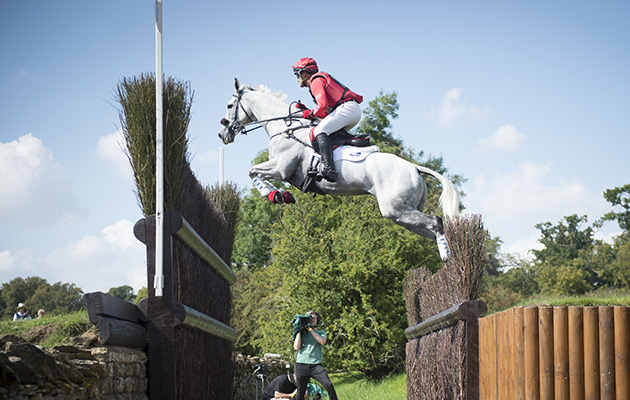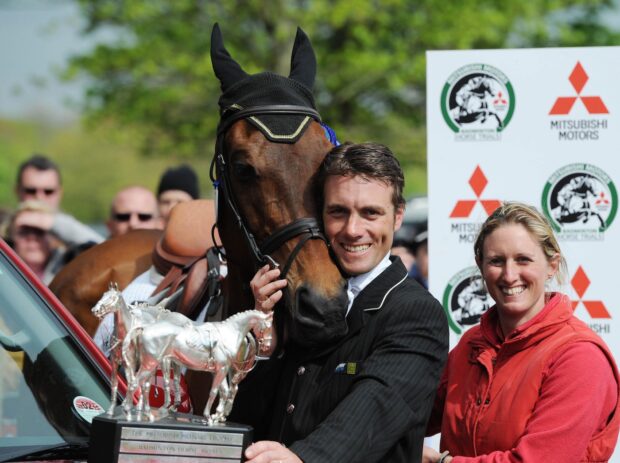The Australian four-star winner turned ‘elite amateur’ talks to Sarah Jenkins about being in constant pain, having an influence, and what would be his last Badminton
Paul Tapner jokes about having to go up a notch on his belt at the beginning of this season. A belt he’s worn for decades with a strong groove where it’s always held the buckle. He still looks a darn sight fitter than your average office-bound 40-something, but blames “all that sitting at a desk” for this tweak to his attire.
Paul wound down his string of eventers two years ago to pursue a career as digital technical director with Event Rider Masters (ERM), more of which shortly. He kept one top horse, Bonza King Of Rouges, who won the eventers’ challenge at the Royal International in July. The plan was to contest Burghley, then Badminton, and for that to be Paul’s last four-star. Then he had to withdraw the horse from Burghley with injury.
“I’d like to get an Armada Dish [for a fifth completion] at Badminton. And I fully expect that to be my last one,” he says, sitting with a pillow behind his back in a shady corner of the garden at Wickstead Farm Equestrian Centre, Tapner Eventing’s base. “I don’t enjoy eventing lower than advanced, I don’t have another four-star horse after King and I wouldn’t expect any owner to buy me one when I’m not doing it full time.”
Paul appears a little exhausted — “I’m still trying to cram too much in, that’s just how I am,” he sighs — but good-humoured for a man who did his back in this morning — hence the pillow.
We’re not far from Badminton, a happy hunting ground for Paul in both metaphorical and literal terms. He won in 2010 with Inonothing, a horse belonging to Jenny Waaler, who part owns King with Angela Scott, who got Paul over here in the first place.
That’s why King stayed, that and, as Paul jokes: “He’s already got a bit of a complex having come to me when Matt Ryan retired, he’d have developed an even worse one if I’d moved him on when I retired, too. He’s unique in his brain and way of working and by the time another rider got the hang of that he’d have been ready to retire.”
This is the horse that lies down if he’s not in the right bit. The rest of the horses were retired or moved on.
“I was sad to see every single one go. It was a difficult time, those were difficult conversations,” he recalls, since some owners were less happy about another rider taking on their horse.
He was lucky to keep his sponsors: “They’d have been well within their rights to drop me,” he says. “I’m very grateful.”
Paul admits to looking for an “exit plan” from pro eventing for years.
“My body couldn’t cope any more and I was having to spend as much time in physio as on the back of a horse,” he says. “I’ve competed with broken collarbones and ribs and fingers. You get good at not letting the doctor know how poorly you are. You have to keep going to keep the rides and qualifications and to keep paying the mortgage.
“I was getting out of bed in pain every morning and would have to do all these exercises even to be able to get on the first horse.
“I tweaked my back this morning doing nothing much and I’m walking around like an old man in agony and I remembered this is what I used to feel like every day.”
As he sought that exit strategy, Paul embarked on a few ventures that “never gave me the financial opportunity to make that leap into another career”. He closed one start-up, Horsehub — a digital platform for purchasing training video — this year.
The idea was you could buy training with a top rider for the price of a coffee.
“Our industry is so used to paying out huge amounts for everything else, perhaps I should have stuck a zero on the end of everything in that app,” he says, only half joking. “Perhaps they think if it’s not crazy money it can’t be good enough.”
Eventing is one of our bizarre sports with its one-way flow of cash from philanthropic owners to riders.
“There’s no way of owners making money from it,” points out Paul, who is now playing a major part in what he hopes will become “the best equestrian series in the world” and help address that imbalance.
ERM is a series of three-star events with revived format, record prize-money, superior digital coverage and a focus on entertainment, bankrolled by event horse owners Christopher and Lisa Stone.
“I’ve often said eventing’s stuck in a 1980s timewarp. Someone told me the other day that was kind and it’s more like the 1940s. The way it’s worked for too long is someone from one group of stakeholders will say how unhappy they are about something and that might change. Then the sport stagnates until the next person from another group makes a lot of noise about something else,” says Paul, who, rather than simply kicking up a fuss, joined forces with minds like broadcaster Alice Fox-Pitt, rider Bruce Haskell, and event horse owners Di Brunsden, Pete Cattell, Tara Glen, Terry Miller and Jeremy Skinner to name a few, to come up with something better. ERM was the result and now in its third year they’ve proved the concept, the business model, and just need to “make it work”, as Paul puts it.
“We’ve got the riders’ support, now we need the spectators’ support.” And advertisers’, too.
He takes pride in ERM proving influential.
“We started with digital scoreboards and now they’re almost the norm,” he says. “You see images of champagne being sprayed around at equestrian events everywhere now. We introduced a clock on the screen that counts down to the optimum time instead of up, and again I’m seeing that elsewhere now. We set the bar.”
Paul seems ambivalent about hanging up his advanced eventing boots after Badminton 2019.
“In the past, by this time of the year I’d have ridden hundreds of hours of cross-country and this year I’ve watched hundreds of hours,” says Paul, who has to know every piece of TV footage for his role. “There was a point in 2016 I was struggling to cope with the fact I’d watch riders like Christopher Burton and think bloody hell I should be riding like that. But now I can watch and have admiration for them without beating myself up about it.”
Continued below…

‘Elite amateur’ wins back-to-back Hickstead eventers’ challenge titles
“I knew exactly how fast I went last year and how many fewer strides I needed to take [to win]”

Paul Tapner wins Badminton Horse Trials 2010
A delighted Paul Tapner has won his first Badminton Horse Trials on Inonothing for Australia

Subscribe to Horse & Hound magazine today – and enjoy unlimited website access all year round
Now the buckle is back on its most well-worn hole, thanks to hours on his push bike and, more enjoyably, out in a canoe with his son Joshua.
I leave him to become reacquainted with the physio and wish him all the best with his latest venture that I hope will have a lasting positive impact on the sport — for all.
This article first appeared in Horse & Hound magazine on 23 August 2018.
For all the latest equestrian news and reports, don’t miss Horse & Hound magazine, out every Thursday




